NCERT Exemplar Solutions for Class 12 Biology chapter 13 Organisms and Populations
These Solutions are part of NCERT Exemplar Solutions for Class 12 Biology. Here we have given NCERT Exemplar Solutions for Class 12 Biology chapter 13 Organisms and Populations
Multiple Choice Questions
Question 1.
Autecology is the
(a) relation of heterogenous population to its environment
(b) relation of an individual to its environ-ment
(c) relation of a community to its environ-ment
(d) relation of a biome to its environment.
Answer:
(a, b) : Ecology is the study of interactions among organisms and between the organisms and their biotic and abiotic environment. The study of reciprocal relationships between every stage of development of a population/ species/individual and its environment is called autecology.
Question 2.
Ecotone is
(a) a polluted area
(b) the bottom of a lake
(c) a zone of transition between two communi¬ties
(d) a zone of developing community.
Answer:
(c) : The adjacent biotic communities do not always have sharp lines of demarcation between them. There are usually transition zones, the ecotones, between them. An ecotone often has some populations from each adjacent community and some characteristic of itself. The total number of species in ecotone is generally greater than in the adjoining communities, a phenomenon called edge effect.
Question 3.
Biosphere is
(a) a component in the ecosystem.
(b) composed of the plants present in the soil
(c) life in the outer space
(d) composed of all living organisms present on earth which interact with the physical environment.
Answer:
(d) : Biosphere or ecosphere is self-sufficient system. It includes the earth’s atmosphere (air, land, water) that sustains life. In biosphere living organisms interact with their physical environment.
Question 4.
Ecological niche is
(a) the surface area of the ocean
(b) an ecologically adapted zone
(c) the physical position and functional role of a species within the community
(d) formed of all plants and animals living at the bottom of a lake.
Answer:
(c) : Ecological niche is specific part of habitat occupied by individuals of a species which is circumscribed by its range of tolerance, range of movement, microclimate, type of food and its availability, shelter, type of predator and timing of activity. Tadpole and adult frog occupy different ecological niches as the former is herbivorous aquatic while the latter is carnivorous amphibian.
Question 5.
According to Allen’s Rule, the mammals from colder climates have
(a) shorter ears and longer limbs
(b) longer ears and shorter limbs
(c) longer ears and longer limbs
(d) shorter ears and shorter limbs.
Answer:
(d) : According to Allen’s Rule, animals in colder climates generally have smaller extremities like shorter ears and limbs. It is a mechanism to conserve heat by checking heat loss from the body. Heat loss can be minimised by decreasing the surface area to volume ratio of body. In the polar regions, small animals are rarely found because of their high surface area and less volume.
Question 6.
Salt concentration (salinity) of the sea measured in parts per thousand is
(a) 10-5
(b) 30-70
(c) 0-5
(d) 30-35
Answer:
(d) : Salinity of water bodies is generally measured in parts per thousand. It determines what kind of organisms can live in it. Salinity of the sea is 30-35 parts per thousand, while for inland waters and some hypersaline lagoons it is less than 5 and more than 100 per thousand parts, respectively. Fresh water animals generally cannot. live for long in sea water and vice versa because of osmotic problems.
Question 7.
Formation of tropical forests needs mean annual temperature and mean annual precipitation as
(a) 18-25°C and 150-400 cm
(b) 5-15°C and 50-100 cm
(c) 30-50°C and 100-150 cm
(d) 5-15°C and 100-200 cm.
Answer:
(a) : Temperature and precipitation are generally most important climatic abiotic factors that influence the geographical distribution of plants. Average temperature decreases from equator to the poles. Precipitation includes rainfall, snow, dew, etc. Tropical forests, which are very productive, need 18 to 25°C mean annual temperature and 150-400 cm mean annual rainfall.
Question 8.
Which of the following forest plants controls the light conditions at the ground?
(a) Lianas and climbers
(b) Shrubs
(c) Tall trees
(d) Herbs
Answer:
(c) : In a forest, plants get arranged in various strata according to their shade tolerance. Tall trees form the canopy of the forest i.e., roof of the forest, thus, controlling the amount of light reaching the ground.
Question 9.
What will happen to a well growing herbaceous plant in the forest if it is transplanted outside the forest in a park?
(a) It will grow normally.
(b) It will grow well because it is planted in the same locality.
(c) It may not survive because of change in its microclimate.
(d) It grows very well because the plant gets more sunlight.
Answer:
(c) : Herbaceous plants are of small height. Since, this herbaceous plant is growing in forest, it must have been adapted to the light intensity reaching it, moisture in surrounding air and soil, soil characteristics, etc. This constitutes the microclimate of this plant. If this plant is transplanted to a park outside forest, this microclimate might get lost, partially or completely, because of which plant might not be able to survive.
Question 10.
If a population of 50 Paramecium present in pool increases to 150 after an hour, what would be the growth rate of population?
(a) 50 per hour
(b) 200 per hour
(c) 5 per hour
(d) 100 per hour
Answer:
(d). Population of Paramecium at time t = 50
Population of Paramecium 1 hour after t= 150
Growth rate of population = 150 – 50 per
hour = 100 per hour
Question 11.
What would be the percent growth or birth rate per individual per hour for the same population mentioned in the previous question (Question 10)?
(a) 100
(b) 200
(c) 50
(d) 150
Answer:
(b) : Initial number of Paramecium = 50
Number of Paramecium after 1 hour = 150 Birth rate

Question 12.
A population has more young individuals compared to the older individuals. What would be the status of the population after some years?
(a) It will decline.
(b) It will stabilise.
(c) It will increase.
(d) It will first decline and then stabilise.
Answer:
(c) : If in a population more young individuals are present as compared to older individuals, population will increase after some years. This is because of the reason that number of individuals in pre-reproductive age is high and thus, more number of individuals will enter the reproductive age in coming years. Such a population can be represented by an age structure forming an upright pyramid.

Question 13.
What parameters are used for tiger census in our country’s national parks and sanctuaries?
(a) Pug marks only
(b) Pug marks and faecal pellets
(c) Faecal pellets only
(d) Actual head counts
Answer:
(b) : In our country, parameters for tiger census in national parks and sanctuaries include both pug marks and faecal pellets. They can be used to determine the number as well as distribution of tiger population. New techniques of excreta DNA analysis and camera trappings are considered more accurate for tiger census.
Question 14.
Which of the following would necessarily decrease the density of a population in a given habitat?
(a) Natality > mortality
(b) Immigration > emigration
(c) Mortality and emigration
(d) Natality and immigration
Answer:
(c) : Population density in a given habitat is influenced by four processes :
- Natality : It is the number of births in a population during a given period of time.
- Mortality : It is the number of deaths in a population during a given period of time.
- Immigration : Number of individuals coming from other habitats in a given period of time
- Emigration : Number of individuals exiting from a given pop-.Tation in a given period of time.
- Mortality and emigration will, therefore decrease the population density while natality and immigration will increase it.
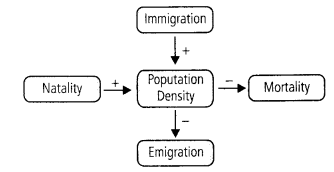
Question 15.
A protozoan reproduces by binary fission. What will be the number of protozoans in its population after six generations?
(a) 128
(b) 24
(c) 64
(d) 32
Answer:
(c) : By binary fission, an individual protozoan will divide in two. In this way after six generations their number will be 64.

Question 16.
In 2005, for each of the 14 million people present in a country, 0.028 were born and 0. 008 died during the year. Using exponential equation, the number of people present in 2015 is predicted as
(a) 25 millions
(b) 17 millions
(c) 20 millions
(d) 18 millions.
Answer:
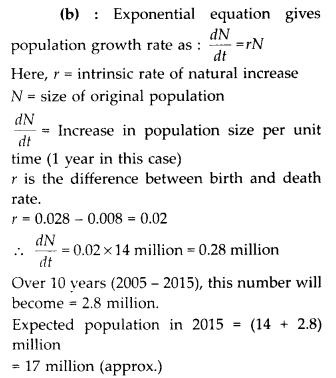
Question 17.
Amensalism is an association between two species where
(a) one species is harmed and other is benefited
(b) one species is harmed and other is unaffected
(c) one species is benefited and other is , unaffected
(d) both the species are harmed.
Answer:
(b) : Amensalism is the interaction between two populations in which oneis adversely affected, whereas other is apparently, neither harmed nor benefited. For example, Penicilliitm does not allow the growth of Staphylococcus bacterium by secreting certain chemicals.
Question 18.
Lichens are the associations of
(a) bacteria and fungus
(b) algae and bacterium
(c) fungus and algae
(d) fungus and virus.
Answer:
(c) : Lichens are association (mutually beneficial) between fungus and alga. The fungal partner is mycobiont and algal partner is phycobiont. Lichens can grow in extremely inhospitable conditions. In many ecosystems they are the pioneer species. The role of mycobiont is to provide body structure and anchorage and absorption of minerals and water. The role of phycobiont is to manufacture food through photosynthesis for itself and also for fungus.
Question 19.
Which of the following is a partial root parasite?
(a) Sandal wood
(b) Mistletoe
(c) Orobanche
(d) Ganoderma
Answer:
(a) : Parasites can be divided into : holo- parasitesandhemiparasites. Holoparasitesare those which are dependent on their host for all of their requirements, while hemiparasites are those, which receive only a part of their nourishment from host. Holoparasites and hemiparasites are also known as complete and partial parasites, respectively. Sandal wood is partial root parasite, which synthesises its own food but is dependent on host’s roots for water and inorganic nutrients. Mistletoe is partial stem parasite. Orobanche (Broomrope) is complete root parasite. Ganoderma, a fungus, is parasitic on hardwood.
Question 20.
Which one of the following organisms reproduces sexually only once in its lifetime?
(a) Banana plant
(b) Mango
(c) Tomato
(d) Eucalyptus
Answer:
(c) : Since tomato is an annual plant, so it reproduces sexually only once in its life time.
Very Short Answer Type Questions
Question 1.
Species that can tolerate narrow range of temperature are called …………
Answer:
stenothermal organisms
Question 2.
What are eurythermic species?
Answer:
Eurythermal organisms are those which can tolerate wide range of temperature variations, e.g., most mammals and birds.
Question 3.
Species that can tolerate wide range of salinity are called
Answer:
eurvhaline species
Question 4.
Define stenohaline species.
Answer:
Species which can tolerate only a narrow range of salinity are called stenohaline species e.g., sharks.
Question 5.
What is the interaction between two species called?
Answer:
The interaction between two species is called interspecific interaction, it can be positive, negative or neutral.
Question 6.
What is commensalism?
Answer:
Commensalism isanassociation between two organisms, in which one is benefited and second is neither harmed nor benefited. E.g., interaction between sucker fish and shark.
Question 7.
Name the association in which one species produces poisonous substance or a change in environmental conditions that is harmful to another species.
Answer:
In amensalism one organism inhibits the growth of the other. This inhibition is done by secreting chemicals called allochemics.
Question 8.
What is mycorrhiza?
Answer:
Symbiotic association between fungus and the roots of higher plants is called mycorrhiza. The fungus helps the plant in absorption of essential nutrients from the soil, while the plant in turn provides the fungus with energy yielding carbohydrates.
Question 9.
Emergent land plants that can tolerate the salinities of the sea are called .
Answer:
halophytes
Question 10.
Why do high altitude areas have brighter sunlight and lower temperatures as compared to the plains?
Answer:
Brighter sunlight at high altitudes is due to thinner air and less pollution. High altitudes have lower temperature because as we go higher, air pressure decreases that causes the temperature to be colder at high altitudes.
Question 11.
What is homeostasis?
Answer:
Homeostasis is the ability to maintain constant body temperature and osmotic concentration irrespective of the environmental conditions.
Question 12.
Define aestivation.
Answer:
The period of dormancy or suspended metabolism during summer months to escape from heat and unfavourable conditions is called aestivation or summer sleep, c.g., snails undergo aestivation to avoid heat and dessication.
Question 13.
What is diapause and its significance?
Answer:
Diapause is the stage of suspended development. During stress period, many zooplanktons and larvae of insects suspend their development and enter a stage of dormancy. They resume their growth during favourable conditions. This helps organisms to escape harsh, extreme conditions.
Question 14.
What would be the growth rate pattern, when the resources are unlimited?
Answer:
When resources like food, space, etc., are unlimited for a population, it grows in an exponential or geometric ratio resulting in a J-shaped growth curve, c.g., growth of algal bloom.
Question 15.
What are the organisms that feed on plant sap and other plant parts called?
Answer:
Organisms feeding on plant sap and other plant parts are called phytophagous.
Question 16.
What is high altitude sickness? Write its symptoms.
Answer:
High altitude sickness is experienced at high altitudes (> 3500 m) like Leh, Rohtang Pass, etc. It is due to low atmospheric pressure at high altitude due to which the body does not get enough oxygen. Its symptoms include nausea, fatigue, heart palpitation.
Question 17.
Give a suitable example for commensalism.
Answer:
The cattle egret and grazing cattle show an example of commensalism. The egrets always forage close to where cattle are grazing, because the cattle, as they move, stir up and flush out insects from the vegetation which are otherwise difficult for egrets to find and catch.
Question 18.
Define ectoparasite and endoparasite and give suitable examples.
Answer:
Ectoparasites live on the surface of the host. They suck blood (in animals), or juice (in plants), c.g., lice on humans and ticks on dogs.
Endoparasites live inside the body of host Most of them spend a part of their life cycle in another host. Their life cycle is more complex because of their extreme specialisation, c.g., Plasmodium in RBCs and Taenia solium in intestine.
Question 19.
What is brood parasitism? Explain with the help of an example.
Answer:
Brood parasitism is an example of parasitism in which the parasitic bird lays its eggs in the nest of its host and the host incubates them. During the course of evolution, the eggs of the parasitic bird have evolved to resemble the host’s eggs in size and colour to reduce the chances of the host bird detecting the foreign eggs and ejecting them from the nest. Most common example is koel whose female lays its eggs in the crow’s nest.
Short Answer Type Questions
Question 1.
Why are coral reefs not found in the regions from West Bengal to Andhra Pradesh but are found in Tamil Nadu and on the east coast of India?
Answer:
Coral reefs are found in zone with high salt concentration (salinity), optimal temperature and with a less siltation condition which fairly facilitate the corals to colonise. In case of high siltation and very high freshwater inflow, coral reefs do not colonise.
Question 2.
If a freshwater fish is placed in an aquarium containing sea water, will the fish be able to survive? Explain giving reasons.
Answer:
freshwater fish is placed in aquarium having sea water, then it would not be able to survive due to osmoregulatory problems. Outer hypertonic environment having high salt concentration would cause exosmosis and fish would die.
Question 3.
Why do all the freshwater organisms have contractile vacuoles whereas majority of marine organisms lack them?
Answer:
Osmotic concentration of freshwater organisms is hypertonic to the surrounding water. The water enters their body by endosmosis. Excess water is expelled out of the body through contractile vacuole. Osmotic concentration of most of the marine organisms is almost equal to surrounding water, i.e., isotonic to surroundings, therefore, they need pot expel extra water out of their body and hence lack contractile vacuole.
Question 4.
Define heliophytes and sciophytes. Name a plant from your locality that is either heliophyte or sciophyte.
Answer:
Plants adapted to bright light are known as heliophytes and are commonly called sun plants. E.g., sunflower.
Plants growing in partial shade or low intensity of light are called sciophytes or shade plants. E.g., money plant.
Question 5.
Why do submerged plants receive weaker illumination than exposed floating plants in a lake?
Answer:
There is a light zonation in deep lakes and oceans. Floating plants are found in upper part of lake and receive more light, however less light penetrates into deep lake and thus submerged plants receive weaker illumination of light.
Question 6.
In a sea shore, the benthic animals live in sandy, muddy and rocky substrata and accordingly developed the following adaptations.
(a) Burrowing
(b) Building cubes
(c) Holdfasts/peduncle
Find the suitable substratum against each adaptation.
Answer:
ln a sea shore, water current restrict distribution of organisms. In streamed areas of ocean, animals are strong swimmers or possess attaching organs such as pedunde, or live under stone, in burrows etc. Burrowing animals like tubeworm, Nereis are strong swimmers. Burrowing, building cubes and hold fast or penduncle are found in sandy muddy and rocky substratum respectively.
Question 7.
Categorise the following plants into hydrophytes, halophytes, mesophytes and xerophytes. Give reasons for your answer.
(a) Salvinia
(b) Opuntia
(c) Rhizophora
(d) Mangifera
Answer:
(a) Salvinia – Hydrophyte – Free floating aquatic plant
(b) Opuntia – Xerophyte – Grows in hot, dry conditions with less rainfall.
(c) Rhizophora – Halophyte – Grows in saline soil.
(d) Mangifera – Mesophyte – Grows in mesic (moderate) conditions with high moisture.
Question 8.
In a pond, we see plants which are free-floating; rooted-submerged; rooted emergent; rooted with floating leaves. Write the type of plants against each of them.”
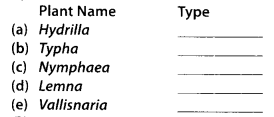
Answer:
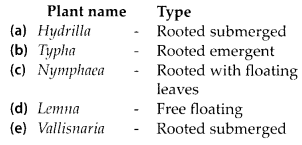
Question 9.
The density of a population in a habitat per unit area is measured in different units. Write the unit of measurement against the following:
(a) Bacteria …………
(b) Banyan …………
(c) Deer ………….
(d) Fish …………..
Answer:
(a) Bacteria – Number per unit volume
(b) Banyan tree – Biomass per unit area
(c) Deer – Number per unit area
(d) Fish – Weight per unit area
Question 10.
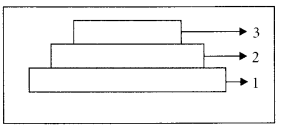
(a) Label the three tiers 1, 2, 3 given in the above age pyramid.
(b) What type of population growth is represented by the above age pyramid?
Answer:
(a)
1 – Pre-reproductive individuals
2 – Reproductive individuals
3 – Post-reproductive individuals
(b) Given age pyramid has broad base or triangular structure which indicates a rapidly expanding population with a high percentage of young individuals and only few old individuals.
Question 11.
In an association of two animal species, one is a termite which feeds on wood and the other is a protozoan Trichonympha present in the gut of the termite. What type of association they establish?
Answer:
Termites and Trichonympha show mutualistic relationship. Termites feed on wood though they do not possess enzymes for digesting the same. Termites harbour cellulose digesting flagellates (e.g., Trichonympha campanula) for this purpose. Flagellates are unable to live independently. Termites would die of starvation in the absence of flagellates.
Question 12.
Lianas are vascular plants rooted in the ground and maintain erectness of their stem by making use of other trees for support. They do not maintain direct relation with those trees. Discuss the type of association the lianas have with the trees.
Answer:
Lianas are woody vascular climbers. They maintain their erectness of stem by using the support of the tree without any direct relation with it. In this relation, lianas are benefited, but the tree neither gets benefit nor is harmed. It represents commensalism, in which one is benefited and other remains unaffected.
Question 13.
Give the scientific names of any two microorganisms inhabiting the human intestine.
Answer:
Escherichia coli and Lactobacillus are two microorganisms which inhabit human intestine.
Question 14.
What is a tree line?
Answer:
The tree line is the edge of the habitat till which trees are capable of growing. Beyond the tree line, trees cannot tolerate the environmental conditions, like, temperature, humidity. Beyond this limit trees are not found.
Question 15.
Define ‘zero population growth rate’. Draw a age pyramid for the same.
Answer:
When birth rate and death rate become equal and there is no increase in population, it is called zero population growth. It is obtained when the number of pre-reproductive and reproductive individuals is almost equal and post-reproductive individuals are comparatively

Question 16.
List any four characters that are employed in human population census
Answer:
Census is an official counting of population and preparing data considering various population characteristics, such as :
- Birth rate
- Sex ratio
- Death rate
- Age distribution
Question 17.
Give one example for each of the following types.
(a) Migratory animal
(b) Camouflaged animal
(c) Predator animal
(d) Biological control agent
(e) Phytophagous animal
(f) Chemical defence agent
Answer:
(a) Migratory animal – Arctic tern
(b) Camouflaged animal – Leaf insect
(c) Predator animal – Lion
(d) Biological control agent – Gambusia
(e) Phytophagous – Butterfly
(f) Chemical defense agent – Cardiac glycosides produced by Calotropis
18.
Fill in the blanks:
|
Species A |
Species B |
Type of Interaction | Example |
| + | – | ||
| + | + | ||
| + | Commensalism |
Answer:
|
Species A |
Species B |
Type of Interaction | Example |
| + | – | Predation | Tiger and Deer |
| + | + | Mutualism | Lichen |
| + | O | Commensalism | Sucker fish and shark |
Question 19.
Observe the set of 4 figures A, B, C and D and, answer the following questions.
- Which one of the figures shows mutualism?
- What kind of association is shown in D?
- Name the organisms and the association in
- What role is the insect performing in B?
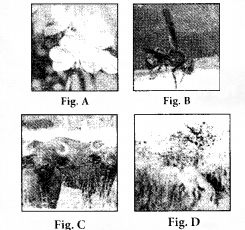
Answer:
- Fig. A shows mutualism, in plant- animal relationship. Plants need the help of animals for pollinating their flowers. Animals get rewards in the form of pollen and nectar.
- Fig. D shows predation where, tiger is the predator and deer is a prey.
- Fig. C shows commensalism between the cattle egret and grazing cattle. The cattle egret and grazing cattle show an example of commensalism. The egrets always forage close to where cattle are grazing, because the cattle, as they move, stir up and flush out insects from the vegetation which are otherwise difficult for egrets to find and catch.
- In fig. B, insect is scavenging, i.c., it is ‘ feeding on dead and decaying matter.
Long Answer Type Questions
Question 1.
Comment on the following figures 1,2 and 3. A, B, C, D, G, P, Q, R and S are species.
Answer:
In fig. 1, all the individuals are of same species and show intraspecific competition. Here, all the members of species have similar requirements of food, light, water, space, shelter and mate.
In Fig. 2, there are individuals of three different species (A, B and C) and have interspecific competition. Here two or more populations usually belonging to same trophic level or feeding habit compete with one another for natural resources. E.g., tigers and leopards may compete for same prey in forest, trees, shrubs, herbs and vines compete for water, sunlight, nutrients, pollinators, etc.
In Fig. 3, three different biotic communities interact with one another and with their physical environment and exchange energy and material with surroundings. It represents a biome.

Question 2.
An individual and a population has certain characteristics. Name these attributes with definitions.
Answer:
An individual or an organism is the smallest unit of ecological hierarchy.Characteristics of an individual are :
- It performs all body functions indepen-dently, but cannot live in isolation.
- It depends on both biotic and abiotic environment.
- It reproduces to give rise to young ones.
- Organism is well adapted to the environment and has a definite life span.
Population is the total number of individuals of a species in a specific geogra¬phical area.
Characteristics of population are:
- Natality : It refers to the number of births during a given period in the population that are added to the initial density.
- Mortality : It is the number of deaths in the population during a given period.
- Immigration : It is the number of individuals of the same species that have come into the habitat from elsewhere during the time period.
- Emigration : It is the number of individuals of the population who left the habitat and gone elsewhere during the time period.
- Sex ratio : Number of females produced per 1000 males.
Question 3.
The following diagrams are the age pyramids of different populations. Comment on the status of these populations.

Answer:
Fig. A shows a triangular age pyramid. It indicates that number of individuals in pre-reproductive age group are much more than those in reproductive age group, which in turn are more than the individuals in post reproductive age group. This type of population shows rapid growth and is known as expanding population. Fig. B is a bell shaped age pyramid. Here, individuals in pre-reproductive age group and reproductive age group are almost same. Such population show the zero growth rate because death rate and birth rate are equal. The population is termed as stable or stationary population.
Fig. C shows an urn shaped age pyramid.
Here, . number of individuals in pre- reproductive age group are less than number of individuals in reproductive age group. Number of post-reproductive individuals is also sizeable. Death rate is more than the birth rate and this pyramid shows declining population.
Question 4.
Comment on the growth curve given below.
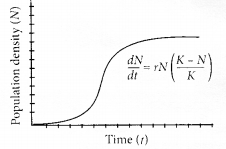
Answer:
The given growth model shows logistic growth, where the resources are limited and a given habitat can support certain number of individuals. The limit beyond which population cannot grow further is known as carrying capacity. Population shows sigmoid growth curve, (S-shaped curve) and has following phases – lag phase, log phase, exponential phase and stationary phase.
This population growth is called Verhulst – Pearl logistic growth, it has following equation :

where,
N = Population density at a time
K = Carrying capacity
r = Intrinsic rate of natural increase.
Question 5.
A population of Paramecium caudatum was grown in a culture medium. After 5 days the culture medium became overcrowded with Paramecium and had depleted nutrients. What will happen to the population and what type of growth curve will the population attain? Draw the growth curve.
Answer:
Paramecium caudatum when grown in a culture medium will show logistic or sigmoid growth curve. Such type of growth occurs when a population is growing in a habitat with ‘limited resources. The population of Paramecium initially shows a lag phase followed by phase of exponential growth as the nutrients and space will be abundant in nutrient medium. When the resources get depleted, the population density starts decreasing and finally the population density reaches carrying capacity beyond which no further growth is possible.
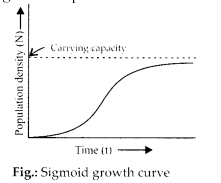
Question 6.
Discuss the various types of positive interactions between species.
Answer:
In positive population interactions, both members involved are either benefited or one is benefited and other remains unaffected. Types of positive interactions are as follows :
(1) Mutualism – An interaction between two organisms of different species where both the partners are benefited. Examples of symbiosis or mutualism are lichens, symbiotic nitrogen fixation, mycorrhizae etc.
Lichen is a composite entity which is formed jointly by an alga (phycobiont) and a fungus (mycobiont). The main body of the lichen is formed of fungus. The fungus also provides, water, minerals and shelter to the alga. The alga manufactures food not only for itself but also for the fungus. This interaction or relationship allows the lichen to grow in highly hostile environment like bare rock,
(2) Commensalism – It is the relationship between two living individuals of different species in which one is benefited while the other is neither harmed nor benefited except to a negligible extent. E.g., sucker fish attaches itself to the under-surface of shark with the help of its dorsal fin which is modified into holdfast. Sucker fish gets a free ride. It is widely dispersed and remains protected from its predators. Sucker fish detaches itself from shark w’hen the latter is feeding to obtain smaller pieces of food.
Question 7.
In an aquarium two herbivorous species of ‘fish are living together and feeding on phytoplanktons. As per the Gause’s principle, one of the species is to be eliminated in due course of time, but both are surviving well in the aquarium. Give possible reasons.
Answer:
According to Gause’s ‘Competitive Exclusion Principle’ two closely related species competing for same resources cannot co-exist indefinitely and the competitively inferior one will be eliminated eventually. If two herbivorous species of fish are co-existing in same ecological niche, then it might be possible that the two herbivorous species of fish may have developed different specialisations, i.e., they may have evolved mechanisms to encourage co-existence, e.g., resource partitioning.
Question 8.
While living in and on the host species, the animal parasite has evolved certain adaptations. Describe these adaptations with examples.
Answer:
Parasites living inside or outside the bodies of host species evolve certain special adaptations to have better survival. The few parasitic adaptations are as follow’s:
- Parasites living in intestine usually develop a covering called cuticle to resist digestive enzvmes of the host, e.g., Ascnris.
- Endoparasites undergo anaerobic respi-ration.
- Some develop adhesive structures to avoid expulsion, e.g., hooks and suckers in tapeworm.
- Loss of locomotorv organs and absence of joined appendages, e.g., Sacculimi.
- High rate of reproduction to compensate loss during transfer from one host to another.
- Simplified sense organs and nervous system.
Question 9.
Do you agree that regional and local variations exist within each biome? Substantiate your answer with suitable example.
Answer:
Abiome is a major ecological communitv or complex of communities characterised by a major vegetation type and distinct landscape
characters. Different types of flora and fauna exist in a biome. Climate is the main factor that determines the type of soil which in turn determines the type of vegetation. The type of vegetation and climate together determine the type of animal population inhabiting the area. The organisms of a biome are adapted to the climatic conditions associated with the region. There are no distinct boundaries between adjacent biomes which merge gradually with each other.
World major biomes include tropical forests, savanna, deserts, polar regions, chaparral, temperate grasslands, temperate deciduous forests, coniferous forests and tundra. Each biome has regional and local variations so that there is wide variety of habitats and ecological niches. For example, the temperate broad leaf and mixed forests biome include a number of distinct ecoregions with characteristic species. In the south, the middle Atlantic coastal forest occupies the flat Atlantic coastal plain, from the eastern shore of Maryland and Delaware to just south of Georgia. The river swamp or bottom land forests in this ecoregion are dominated by majestic bald cypress and swamp tupelo. Farther north, the north eastern forest type is typified by white and red oak.
Question 10.
Which element is responsible for causing soil salinity? At what concentration does the soil become saline?
Answer:
The most important element responsible for causing soil salinity is Na present as NaCl in the soil. Chlorides, nitrates, sulphates and carbonates of potassium, magnesium and ^sodium; chlorides and nitrates of calcium are important elements to make soil more saline.
Question 11.
Does light factor affect the distribution of organisms? Write a brief note giving suitable examples of either plants or animals.
Answer:
Light is an important abiotic factor responsible for growth, development and distribution of plants. There are three parameters of light.
- Light intensity,
- Light quality
- Light duration
(1) Decreasing light intensity at various depths in ocean determines distribution of plants.
Green algae – found along the shoreline Brown algae – deeper level Red algae – Very deep in water
(2) Terrestrial communities are regulated by light. The dominant species occupy highest canopy level to utilise maximum light. The quantity and quality of light result in different types of plants growing in different areas in various states.
(3) Day length varies, when we move from equator to poles, it plays important role in plant distribution. According to duration of light available to the plants, they can be long day plants, short day plants or day neutral plants. The flowering period varies depending on the availability and duration of light.
Question 12.
Give one example for each of the following:
- Eurythermal plant species
- A hot water spring organism
- An organism seen in deep ocean trenches
- An organism seen in compost pit
- A parasitic angiosperm
- A stenothermal plant species
- Soil organism
- A benthic animal
- Antifreeze compound seen in antarctic fish
- An organism which can conform
Answer:
- Eurvthermal plant species – Artemcsin.
- A hot water spring organism – Thermits aquatints
- An organism seen in deep ocean trenches – Euplectclla
- An organism seen in compost pit – Pseudomonas
- A parasitic angiosperm – Cuscuta
- A stenothermal plant species – Coconut
- Soil organism – Earthworm
- A benthic animal – Sponge
- Antifreeze compound seen in antarctic fish – Glycoprotein
- An organism which can conform – Asterias
We hope the NCERT Exemplar Solutions for Class 12 Biology chapter 13 Organisms and Populations help you. If you have any query regarding .NCERT Exemplar Solutions for Class 12 Biology chapter 13 Organisms and Populations, drop a comment below and we will get back to you at the earliest.